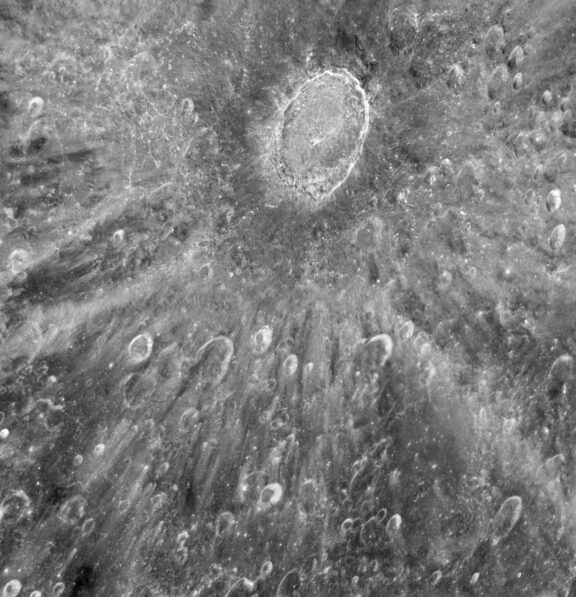What would happen if an asteroid hit the Moon?

Written by
Kate Howells
Public Education Specialist, The Planetary Society
August 24, 2023
Asteroids are abundant in the Solar System, and some have orbits that bring them close to Earth. Planetary defense is the effort to prevent asteroids from hitting the Earth, but what about the Moon? If an asteroid were to impact our natural satellite, what would happen?
It’s happened before, and it’ll happen again
The Moon’s cratered surface is proof that it gets the occasional celestial wallop. Estimates of the number of craters on the Moon range from hundreds of thousands to millions. Some are the remnants of ancient volcanic explosions, but most were formed by impacts. Many of these impacts happened billions of years ago when the Solar System was more crowded and collisions were more common. While the Earth’s tectonic activity and erosion have erased most of its craters, the Moon shows almost its entire impact history — including some huge craters formed by large asteroids.

Although asteroid impacts are now much more rare, smaller impacts from meteoroids (smaller than one meter or three feet in diameter) still happen on the Moon every day, just like they do on Earth. Whereas our planet’s atmosphere burns up most meteoroids that intersect our orbit, the Moon has nothing to burn up or even slow down an incoming rock. Traveling at speeds as great as 72 kilometers per second (160,000 miles per hour), even a small rock can create a sizable crater.
What would a large impact do?
If a large asteroid were to impact the Moon, it would create a large crater that would eject a lot of material from the surface, but that would be the extent of the damage. There aren’t any asteroids large enough to split the Moon apart or knock it off its orbit around the Earth. In fact, the total mass of all the Solar System’s asteroids combined is less than the mass of the Moon.
Impactors that would cause widespread damage on Earth would not cause nearly the same problems if they impacted the Moon, even though there’s no lunar atmosphere to slow them down. The reason is simple: there’s nothing to destroy on the Moon. Damage on Earth is not about the rock underneath us being disturbed, but about the structures, ecosystems, and individual lives that are affected. On the Moon, the only thing that would be affected by an impact is the rock of the lunar surface.
Although it’s possible that an impact in just the wrong place could disturb the historically significant Apollo landing sites, the chances of that happening are very slim. The Moon's surface area is about 38 million square kilometers (14.6 million square miles), and even with smaller meteoroids that impact more frequently, any given square kilometer patch of ground only gets hit every thousand years or so by an object the size of a ping pong ball or larger.
How likely is a large asteroid impact?
Potentially hazardous asteroids are those larger than about 140 meters (460 feet) with orbits that bring them within 7.5 million kilometers (4.5 million miles) of Earth’s orbit — which would also bring them close to the Moon. As of March 2023, NASA has identified around 2,300 asteroids that are considered potentially hazardous. All of their trajectories have been calculated, and none threaten Earth (or, therefore, the Moon) for at least the next 100 years. Smaller asteroids are more likely to sneak up on us, and are therefore more likely to impact the Moon as well as Earth.

What would a lunar impact look like from Earth?
From our point of view on Earth, a large impact on the Moon would most likely be a fascinating and wondrous thing.
Our spacecraft might observe and record the impact itself, and depending on the time of day or night, observers on Earth might be able to see a bright flash. After the impact, we would get to see a new crater appear on the lunar surface. Both of these phenomena have in fact been observed in the past.
If material was ejected from the Moon with enough force to reach the Earth, those small rocks would burn up in the atmosphere much like a meteor shower, creating a beautiful spectacle for us to witness. If any of the pieces of Moon rock were large enough to make it to the surface, they would be unlikely to be large enough to cause damage; they’d be more like particularly scientifically valuable meteorites.
What can we do to prevent asteroids impacting the Moon?
Although an impact on the Moon wouldn’t be harmful to life on Earth, any large asteroid that seems to be heading for an impact with the Moon would be considered potentially hazardous to Earth because of our proximity.
Planetary defense is the effort to find, track, characterize, and — if needed — deflect asteroids that might get close to the Earth-Moon system. The Planetary Society advocates and fundraises in support of planetary defense missions and projects, and space agencies around the world contribute to planetary defense efforts.
DART, NASA's Double Asteroid Redirection Test, was the first space mission to test an asteroid deflection technique. DART launched in November 2021 and arrived at near-Earth asteroid Didymos in September 2022. On Sept. 26, the spacecraft intentionally crashed into the asteroid's small moon, Dimorphos. The crash changed the time it takes Dimorphos to orbit Didymos by 33 minutes, proving that the deflection technique of using what's called a kinetic impactor works.
With proper planning and investment, we will know far in advance if an asteroid is going to impact the Moon, and we can prevent it from even coming close to our planet.
Support our core enterprises
Your gift today will go far to help us close out the year strong and keep up our momentum in 2026.
Donate

 Explore Worlds
Explore Worlds Find Life
Find Life Defend Earth
Defend Earth

